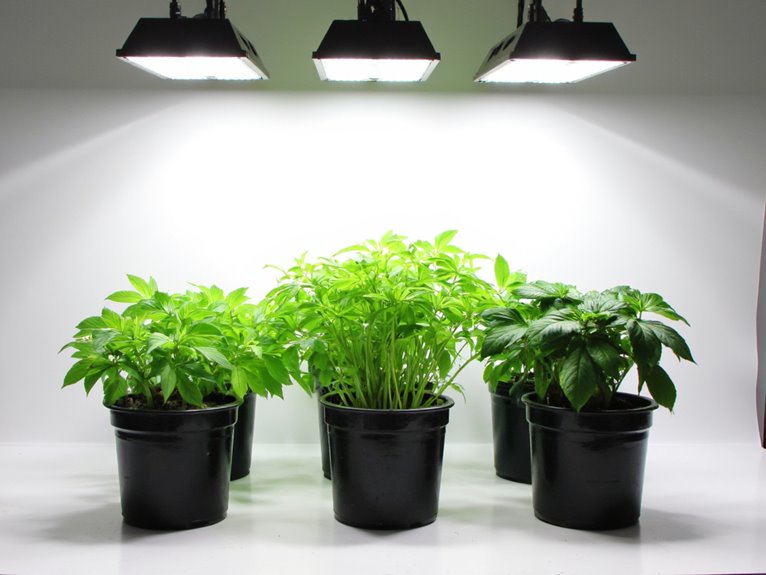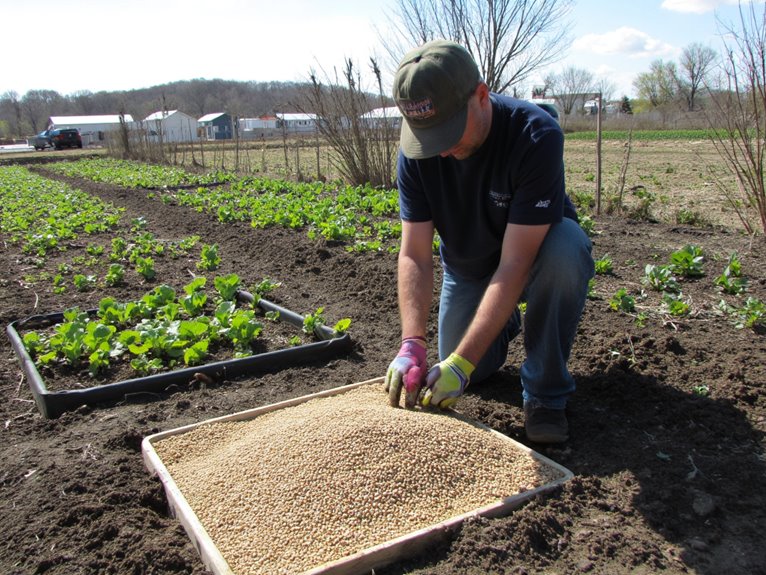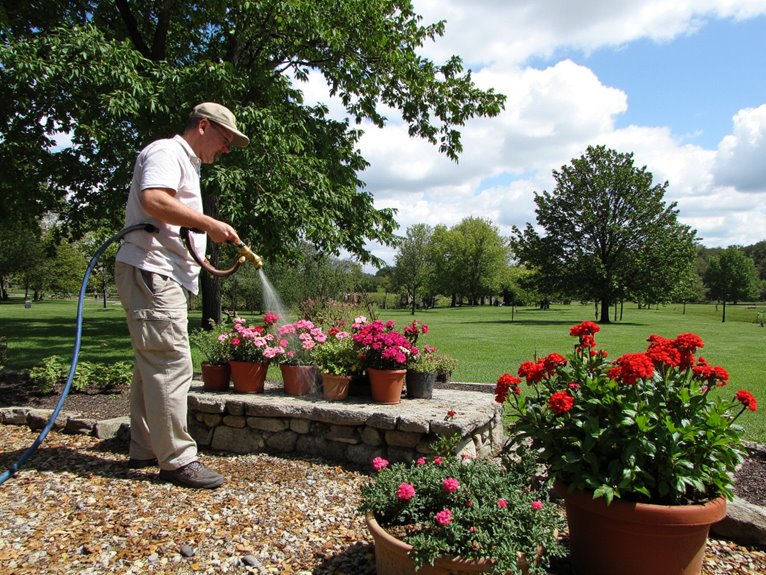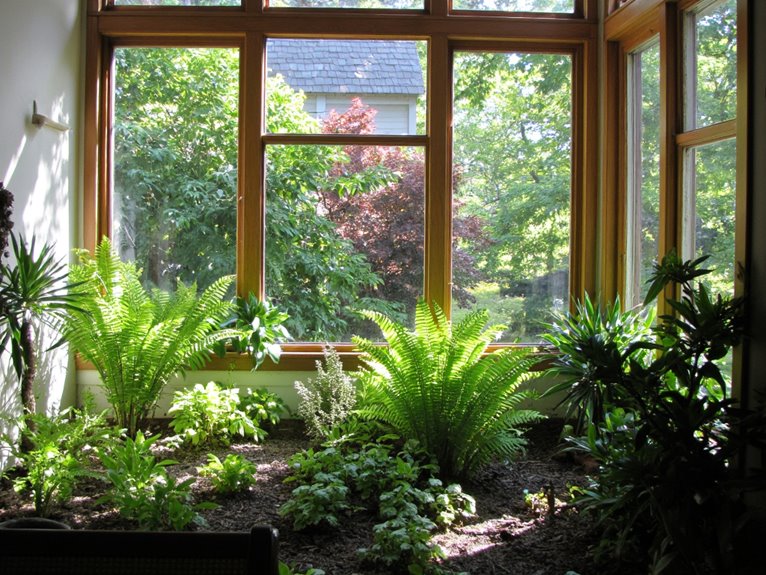Seasonal Plant Movement: Adjusting Garden Plant Locations as Light Conditions Change
As seasons shift, so does your garden’s light — remember, south-facing spots get more sun in winter than summer. Consider moving shade-loving plants to north walls in spring or relocating sun-starved containers to east-facing decks in fall. When transplanting, wrap roots in sphagnum moss and avoid midday heat to reduce stress. Observe how tree canopies filter light differently each year and experiment with trellises or reflective surfaces to maximize what you’ve got. By matching plants to their changing needs, you’ll watch them thrive through the seasons — and discover that gardening is as much about adaptation as it is about planting.
Notable Insights
- Adjust plant locations seasonally to match their light needs as sun exposure changes throughout the year.
- Prioritize south-facing spots for sun-loving plants and north-facing areas for shade-tolerant varieties.
- Monitor leaf color, stem length, and overall health to determine if plants require more or less sunlight.
- Use reflective surfaces or trellises to redirect light to shaded areas and manage intense midday sun.
- Relocate plants during dormancy or slow growth periods to minimize stress from environmental changes.
Understanding Seasonal Light Patterns in Your Garden
As you plan your garden, understanding seasonal light patterns can make all the difference in plant health and beauty, so let’s explore how sunlight changes throughout the year and how to work with it. Seasonal variations mean your garden gets different amounts of light at different times—think intense summer sun versus gentle spring mornings. Plants show impressive light adaptation by changing leaf size and color to suit their environment.
Consider your garden’s orientation: south-facing spots get the most direct sunlight, while north-facing areas stay cooler. Tree canopies also shift with seasons, offering varying shade. By observing these patterns, you’ll better select plants that thrive in your space. Just as hydroponic systems require pH balance monitoring for optimal nutrient absorption, outdoor gardens benefit from understanding how seasonal light changes affect plant metabolism. Remember, even shade-loving plants need some sun—just not the harsh afternoon rays. Light duration directly affects plant growth outcomes, so monitoring how much sunlight each area receives throughout the year is essential for successful gardening.
Evaluating Plant Light Needs for Optimal Placement
One in three gardeners struggle with plant placement, but understanding light needs doesn’t have to be confusing. Light intensity varies dramatically across gardens – from full sun’s 30-50 mol/m²/day to shade’s less than 4 mol/m²/day. Matching plants to these intensities guarantees photosynthesis efficiency, as African violets thrive at 4-6 mol/m²/day while tomatoes need 12-20 mol/m²/day minimum. Evaluate your garden’s light patterns using smartphone cameras to map daily exposure. Consider both quantity and quality – PAR wavelengths (400-700 nm) matter most for photosynthesis. High CRI ratings above 90 indicate rich light quality that benefits plant health and development. Shade plants with large leaves excel at low intensity but scorch under direct sun. Prioritize placing plants where they’ll receive their ideal range, avoiding guesswork and stress. Light measurement tools help identify precise requirements.
Techniques for Relocating Plants With Minimal Stress
Whether you’re expanding your garden or reorganizing your outdoor space, moving plants wisely can make all the difference – timing, technique, and care converge to guarantee a smooth shift. Prioritize relocation timing during dormancy or less active periods to minimize plant stress. Water thoroughly before moving, prune dead branches, and wrap roots in damp burlap for larger specimens. Secure transportation with padding and avoid direct sunlight to prevent overheating. Upon arrival, place plants in locations matching their light needs and maintain consistent conditions. For container gardens, choose pots with reinforced handles to facilitate easy moving and management during seasonal relocations. Monitor closely for signs of shock or disease, providing gradual acclimation and regular care as they recover. With patience and proper technique, your plants will thrive in their new homes.
Be sure to check local plant regulations before relocating certain species, as some areas restrict the transport of specific plants to prevent the spread of pests and diseases.
Maximizing Natural Light Through Environmental Adjustments
Positioning plants where they’ll receive ideal sunlight is just as important as choosing the right species for your climate—sometimes a simple rearrangement can transform a lackluster corner into a thriving garden. Shading strategies like trellises or umbrellas help manage intense midday sun without blocking all light, creating perfect conditions for shade-loving plants. Meanwhile, reflective surfaces such as white-painted walls or mirrored panels bounce sunlight deeper into gardens, brightening even the darkest corners. By understanding how your space interacts with the sun’s path, you can design a garden that thrives year-round with natural light.
Balancing Indoor and Outdoor Exposure Year-Round
As we shift seasons so do our plants’ light needs making balance essential for their health. Full sun plants may need southern exposures in summer but shade during winter months. Remember that indoor humidity levels change with seasonal heating or cooling systems, affecting water requirements. Plants moved indoors often experience drier air needing more frequent watering. When adapting outdoor to indoor environments, gradual acclimation helps prevent shock. Monitor for stress signs like yellowing leaves indicating improper light exposure. Adjust placements based on daylight duration – some plants require specific day lengths to bloom. By understanding these patterns and making thoughtful relocations, we can guarantee our green friends thrive through each seasonal change.
Using Artificial Lighting to Complement Natural Conditions
While balancing light needs indoors and out remains important, artificial lighting opens new possibilities for gardeners looking to extend their green thumbs beyond what nature provides. Artificial light benefits include extending seasons and nurturing plants in low-light spaces. With light spectrum customization—blue for growth, red for blooms—you tailor perfect conditions. Place lights strategically to supplement natural exposure or illuminate shaded corners entirely. This flexibility lets you grow diverse species year-round, from winter herbs to fall vegetables.
Recognizing Signs of Improper Light Exposure in Plants
Whether you’re nurturing houseplants or garden specimens, recognizing light imbalances is key to keeping plants thriving. Excess light causes leaf burn, crispy edges, and wilting despite watering, signaling light stress. Insufficient light leads to yellowing, leggy growth, and sparse foliage—clear plant symptoms. Leaves may curl or droop, while stems stretch toward sunlight. Chronic issues can bleach leaves or halt new growth entirely. Regularly rotating plants prevents leaning and guarantees even exposure. When in doubt, observe how quickly soil dries or compare leaf color to similar species. Addressing light needs promptly stops stress from worsening, helping your greenery recover and flourish.
Creating Dynamic Garden Layouts for Changing Light Conditions
Imagine you’re designing a garden that changes with the seasons—like a living painting that rearranges itself to suit the light. Creating dynamic layouts means embracing modular designs that let you shift plants as conditions evolve. Layered landscaping helps manage shade and sun across the year, ensuring every plant thrives in its new spot. With flexible pathways and adaptable beds, relocations become simple rather than disruptive. Consider how trees grow or decline—shading one area while opening another—and plan accordingly. Regular assessments guide these changes, keeping your garden both beautiful and productive throughout the calendar year.
Frequently Asked Questions
What Light Intensity Is Ideal for Succulents?
The ideal sunlight for succulents is bright, direct light—4 to 6 hours daily. Succulent care means balancing sun exposure with gradual adaptation to avoid stress. High-light plants like echeveria thrive best in south-facing windows or under artificial grow lights.
How Do Artificial Lights Mimic Natural Sunlight?
Artificial lights try to mimic natural sunlight using LED technology that replicates visible light spectrum, but fall short on intensity, infrared, and ultraviolet rays that sunlight provides naturally.
When Should I Prune Plants for Better Light Access?
Prune plants for better light access in late winter or early spring before new growth starts, using pruning techniques like thinning cuts and removing crossing branches. This seasonal timing helps open up the plant’s structure for improved light penetration.
Can Mirrors Increase Indoor Plant Light Exposure?
Yes, mirrors can increase indoor plant light exposure by strategically placing them to bounce natural or artificial light toward plants. Good mirror placement and light reflection help illuminate shaded areas, boosting growth without extra electricity use—just smart positioning!
Do Container Plants Have Different Light Needs Than In-Ground Ones?
Yes, container plants have different light requirements than in-ground ones. Container gardening needs careful placement to balance light quantity and quality, especially indoors. They often need more direct sun or grow lights to thrive, while in-ground plants can rely on natural sunlight distribution.
On a final note
As seasons shift so do your garden’s light patterns. By understanding these changes you can keep plants thriving. Remember every plant has specific needs just like humans do. Don’t be afraid to move them when necessary it helps them grow stronger and healthier. With a bit of planning and care adjusting locations becomes second nature. Happy gardening!






